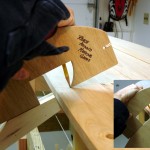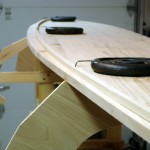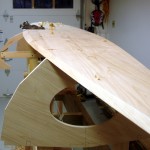It was moderately warmer in the shop yesterday, making for a good day to work on the bottom bevels. We left off with a big bottom board attached to the stems, the mid-frame, and the bulkheads. It stands proud of all of those and needs to have its edges beveled so that the planks can fit neatly. The bottom bevel is a continuously “rolling” bevel. Near the stems it is very steep, something near 60 degrees. At the mid-frame, the bevel is very shallow, near 25 degrees. There are several simple challenges for making this bevel, each easily accomplished.
 First, we need to know the boundaries of the bevel. One part is easy, the existing top edge. The other a bit more difficult. Find the point where the straight line extension of a frame, bulkhead, or stem intersects the bottom surface. The overhanging board prevents the simple use of a straightedge. The trick is “Greg’s (pat. pending) Reach Around Marking Gauge.” Not only does the gauge reach around the edge, I reached around the gauge when making the picture, to make it easier for you to see how the gauge is used.
First, we need to know the boundaries of the bevel. One part is easy, the existing top edge. The other a bit more difficult. Find the point where the straight line extension of a frame, bulkhead, or stem intersects the bottom surface. The overhanging board prevents the simple use of a straightedge. The trick is “Greg’s (pat. pending) Reach Around Marking Gauge.” Not only does the gauge reach around the edge, I reached around the gauge when making the picture, to make it easier for you to see how the gauge is used.
 Connecting only a few marks into a smooth curve is the next step. I have a number of flexible battens that curve easily. They are about 3/8 inch square and 15 feet long. Something is needed to hold the battens to the marks while marking the line. There are nifty tools for this task called drafting ducks, spline weights, or lofting whales. They are basically hunks of metal with a metal rod extended from one end. They are traditionally shaped like ducks or whales, leading to the various names. Find a picture at the WoodenBoat Store. These little goodies are available for a mere $22 to $40 each, and a serious boat builder might need a couple dozen of the things. Being a stingy ole galoot, I found that 3 pound barbell plates with a piece of metal rod drilled and epoxied into them could be made for about $4 each. Not as pretty, but certainly functional. They held the battens still enough to make a fair line.
Connecting only a few marks into a smooth curve is the next step. I have a number of flexible battens that curve easily. They are about 3/8 inch square and 15 feet long. Something is needed to hold the battens to the marks while marking the line. There are nifty tools for this task called drafting ducks, spline weights, or lofting whales. They are basically hunks of metal with a metal rod extended from one end. They are traditionally shaped like ducks or whales, leading to the various names. Find a picture at the WoodenBoat Store. These little goodies are available for a mere $22 to $40 each, and a serious boat builder might need a couple dozen of the things. Being a stingy ole galoot, I found that 3 pound barbell plates with a piece of metal rod drilled and epoxied into them could be made for about $4 each. Not as pretty, but certainly functional. They held the battens still enough to make a fair line.
 With the lines struck, the rest is simple. Use the ancient Stanley low-angle block plane to remove all the material between the board’s edge and the line, rolling the plane as the angle changes. Keeping the surface of the bevel flat is a bit of fussiness, not difficult, but essential to ensuring a good watertight join. Yes, it felt good to be shaping wood again!
With the lines struck, the rest is simple. Use the ancient Stanley low-angle block plane to remove all the material between the board’s edge and the line, rolling the plane as the angle changes. Keeping the surface of the bevel flat is a bit of fussiness, not difficult, but essential to ensuring a good watertight join. Yes, it felt good to be shaping wood again!
Interesting post Bob! I particularly like your drafting donuts! Mmmm….donuts. $4 sure beats $40 – plus, you could still use these to workout!
I love seeing the progress on the boat – it’s really looking great. Watching you work on the Fiddlehead has been inspirational, and combined with a Christmas gift of Gardner’s “Building Classic Small Craft”, I have really been dreaming about boats a lot lately…
Hi Bob, That’s a very nice looking rolling bevel you have there! I too, like the shop made drafting ducks, and the “Greg’s Reach Aroung Measuring Guage”.
Am I correct in thinking that the span of the measuring guage is determined by ensuring that it is long enough to clear the egde of the plank, and short enough to have the lower part rest squarely on the frame, bulkhead, or stem?
Hi Ron.
Neat Jimmy Skiff you built. Looks like great fun!
Yes, you’re right about the marking tool. It’s simply a straight line with a notch cut out, a tool for extending the straight edge of the bulkhead. The reference to “Greg” is Greg Rössell, a fabulous instructor at the Wooden Boat School.
Thanks Bob, I had started to build a 1/6th scale model of Gavin Atkin’s Bluestone. I got as far as gluing on the garboards, but was at a loss for an effective way to mark the bevel outline. I’ll make the guage and resume building when it gets a little warmer.